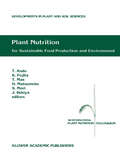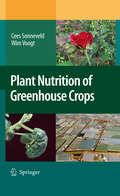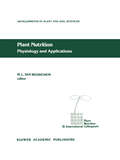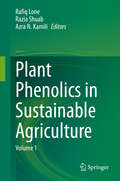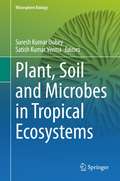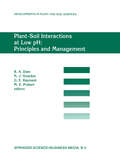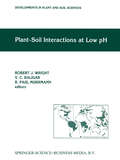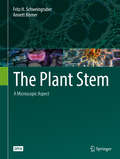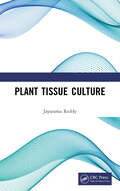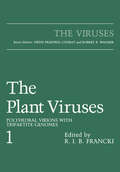- Table View
- List View
Plant Nutrition for Sustainable Food Production and Environment: Proceedings of the XIII International Plant Nutrition Colloquium, 13–19 September 1997, Tokyo, Japan (Developments in Plant and Soil Sciences #78)
by Tadao Ando Kounosuke Fujita Tadahiko Mae Hideaki Matsumoto Satoshi Mori Jiro SekiyaIn the history of the International Plant Nutrition Colloquium from its first meeting in 1954, this meeting, the 13th Colloquium, is the first to be held in Asia and will be the last in the 20th century. The 20th century has seen huge changes in the number and activities of mankind. Our population has increased from around 1. 7 billion to more than 5. 8 billion and technological innovations have completely altered our way of living. As a consequence of such rapid change, we are facing many problems including changes in our environment of a global scale. But, while food shortage has been a serious concern to mankind throughout our history, serious food shortages in the 20th century have been confined to limited times and areas. As Lester Brown discusses in this volume, farmers have increased food production heroically on demand. We, the plant nutritionists should be proud of our support to the world's farmers which has helped them make their achievement possible. During the 20th century, the science of plant nutrition also has achieved great progress as described by Jack Loneragan; it became established as a discipline firmly based in science, defined the chemical elements supporting plant growth, and has contributed to improvements in plant production and environmental quality, as readers will find in many contributions in this volume.
Plant Nutrition of Greenhouse Crops
by Cees Sonneveld Wim VoogtGreenhouse cultivation is noted for its high uptake of minerals, consistent climatic conditions, exclusion of natural precipitation and control of salt accumulation. Acknowledging that plant nutrition in greenhouse cultivation differs in many essentials from field production, this volume details specific information about testing methods for soils and substrates in a greenhouse environment. It does so while offering a universally applicable analysis. This is based on the composition of the soil and substrate solutions, methods for the interpretation of tissue tests, and crop responses on salinity and water supply in relation to fertilizer application. Fertilizer additions, related to analytical data of soil and substrate samples, are presented for a wide range of vegetable and ornamental crops. The subject is especially apt now as substrate growing offers excellent possibilities for the optimal use of water and nutrients, as well as the potential for sustainable production methods for greenhouse crops.
Plant Nutrition - Physiology and Applications (Developments in Plant and Soil Sciences #41)
by M. L. Van BeusichemExactly 35 years after the first Colloquium was held, the Eleventh International Plant Nutrition Colloquium took place from 30 July to 4 August 1989 in Wageningen, The Netherlands. Although impressive progress has been made during the past decades in our understanding of the mechanisms of uptake, distribution and assimilation of nutrients in relation to crop yield and quality, there are still significant gaps in our insight into many fundamental aspects of plant mineral nutrition and related metabolic processes. In spite of improved knowledge of nutrient requirements of crops and improved fertilizer application strategies, the world population remains to be burdened with an enormous shortage of plant products for food, timber, fuel, shelter, and other purposes. The main challenge facing the plant nutrition research community is to at least alleviate the increasing world-wide need for applying scientific knowledge to practical problems in agriculture, horticulture, and forestry. It is therefore felt by many scientists that the Plant Nutrition Colloquia, which are intended to bring together scientists and to integrate knowledge and approaches acquired in plant physiology, biochemis try, soil science, agronomy and related disciplines, have indeed made a significant contribution to the advancement of our knowledge and understanding in this vital and interdisciplinary field of agrobiology. About 260 scientists from 40 nations attended the Colloquium in Wageningen.
Plant Parasitic Nematodes in Sustainable Agriculture of North America: Vol. 1 - Canada, Mexico And Western Usa (Sustainability In Plant And Crop Protection Ser.)
by Sergei A. Subbotin John J. ChitambarPlant-parasitic nematodes are recognized as one of the greatest threats to crop production throughout the world. Estimated annual crop losses of $8 billion in the United States and $78 billion worldwide are attributed to plant parasitic nematodes. Plant parasitic nematodes not only cause damage individually but form disease-complexes with other microorganisms thereby increasing crop loss. Nematode diseases of crops are difficult to control because of their insidious nature and lack of specific diagnostic symptoms which closely resemble those caused by other plant pathogens and abiotic diseases. Future developments of sustainable management systems for preventing major economical agricultural losses due to nematodes is focused on strategies that limit production costs, enhance crop yields, and protect the environment. This book presents a first compendium and overview for nematode problems and their management across North America. Each chapter provides essential information on the occurrence and distribution of plant parasitic nematodes, their major crop hosts, impact on crop production and sustainable management strategies for each region of the continent including, Canada, Mexico and all states of the USA. For each region, a thematic overview of changes in crop production affected by plant parasitic nematodes and their management strategies over time will provide invaluable information on the important role of plant parasitic nematodes in sustainable agriculture.
Plant Parasitic Nematodes in Sustainable Agriculture of North America: Vol. 1 - Canada, Mexico And Western Usa (Sustainability In Plant And Crop Protection Ser.)
by Sergei A. Subbotin John J. ChitambarPlant-parasitic nematodes are recognized as one of the greatest threats to crop production throughout the world. Estimated annual crop losses of $8 billion in the United States and $78 billion worldwide are attributed to plant parasitic nematodes. Plant parasitic nematodes not only cause damage individually but form disease-complexes with other microorganisms thereby increasing crop loss. Nematode diseases of crops are difficult to control because of their insidious nature and lack of specific diagnostic symptoms which closely resemble those caused by other plant pathogens and abiotic diseases. Future developments of sustainable management systems for preventing major economical agricultural losses due to nematodes is focused on strategies that limit production costs, enhance crop yields, and protect the environment. This book presents a first compendium and overview for nematode problems and their management across North America. Each chapter provides essential information on the occurrence and distribution of plant parasitic nematodes, their major crop hosts, impact on crop production and sustainable management strategies for each region of the continent including, Canada, Mexico and all states of the USA. For each region, a thematic overview of changes in crop production affected by plant parasitic nematodes and their management strategies over time will provide invaluable information on the important role of plant parasitic nematodes in sustainable agriculture.
Plant Pheno-morphological Studies in Mediterranean Type Ecosystems (Geobotany #12)
by G. OrshamPhenomorphology of flowering plants deals with starts growing, how long it grows and what happens the study of temporal changes in the morphology of to it when it stops growing. Is it being dispersed like plants and plant organs during their whole life diaspores, does it die eventually like leaves, or does span. It is in fact the study of the visible life history it remain alive as part of the plant body during the of each of the vegetative and generative organs of whole lifespan of the plant or during part of it, and the plant. Consequently it combines the use of finally what is its life duration. Generally only the phenology, which deals with the seasonality of phe life history of leaves, stems, flowers and fruits was nophases (Linnaeus 1751), and of morphology, followed. The following phenophases are de since the morphological changes of the plant as a scribed: vegetative growth, flower bud formation, whole and of its individual organs within and be fruiting, dispersal of diaspores, and leaf shedding. tween the phenophases are described. It is hoped that such a study of plant growth and Man's interest in plant life goes back to prehis development will lead to a better understanding of toric times.
Plant Phenolics in Sustainable Agriculture: Volume 1
by Rafiq Lone Razia Shuab Azra N. KamiliThis book presents the latest research on plant phenolics, offering readers a detailed, yet comprehensive account of their role in sustainable agriculture. It covers a diverse range of topics, including extraction processes; the role of plant phenolics in growth and development; plant physiology; post-harvesting technologies; food preservation; environmental, biotic and abiotic stress; as well as nutrition and health. Further the book provides readers with an up-to-date review of this dynamic field and sets the direction for future research. Based on the authors’ extensive experience and written in an engaging style, this highly readable book will appeal to scholars from various disciplines. Bringing together work from leading international researchers, it is also a valuable reference resource for academics, researchers, students and teachers wanting to gain insights into the role of plant phenolics in sustainable agriculture.
Plant Phenology as a Biomonitor for Climate Change in Germany: A Modelling and Mapping Approach (SpringerBriefs in Environmental Science)
by Gunther Schmidt Simon Schönrock Winfried SchröderThe investigations refer to the development of plant phenology since the 1960s in Germany. Spatiotemporal trends were assessed by means of regression kriging. It could be shown that there already is a distinct shift of phenological onset towards the beginning of the year of up to two weeks. In future, a shift of up to one month was calculated till 2080. Moreover, a prolongation of the vegetation period of up to three weeks was found. The findings are relevant for the development of mitigation measures to prevent from environmental, agricultural and economic issues due to climate change.
Plant-Plant Allelopathic Interactions: Phenolic Acids, Cover Crops and Weed Emergence
by Udo BlumIn an effort to implement conservation measures farmers have used a variety of production methods, including the use of reduced or zero tillage and cover crops. One benefit of these production methods has been early season weed control. The literature suggests that a variety of mechanisms may be involved, among them the allelopathic effects of phenolic acids. This retrospective analysis addresses the following: How likely are phenolic acid concentrations and environmental conditions in wheat no-till cropping systems for the inhibition of annual broadleaf weed emergence? and Do phenolic acids have a dominant role or are they just one component of a larger promoter/modifier/inhibitor complex? The book covers allelopathic plant-plant interactions, laboratory and field experiments, and future research. It uses a journal format, provides justifications for procedures used, if-then hypotheses, and cons and pros so that readers can reach their own conclusions.
Plant Reintroduction in a Changing Climate: Promises and Perils (The Science and Practice of Ecological Restoration)
by Joyce Maschinski, Kristin E. Haskins and Peter H. RavenThis volume presents a comprehensive review of reintroduction projects and practices, the circumstances of their successes or failures, lessons learned, and the potential role for reintroductions in preserving species threatened by climate change. Contributors examine current plant reintroduction practices, from selecting appropriate source material and recipient sites to assessing population demography.The findings culminate in a set of Best Reintroduction Practice Guidelines, included in an appendix to the book. These guidelines cover stages from planning and implementation to long-term monitoring, and offer not only recommended actions but also checklists of questions to consider that are applicable to projects around the world.Plant Reintroduction in a Changing Climate is a comprehensive and accessible reference for practitioners to use in planning and executing rare plant reintroductions.
Plant, Soil and Microbes in Tropical Ecosystems (Rhizosphere Biology)
by Satish Kumar Verma Suresh Kumar DubeyThis book describes the multitude of interactions between plant, soil, and micro-organisms. It emphasizes on how growth and development in plants, starting from seed germination, is heavily influenced by the soil type. It describes the interactions established by plants with soil and inhabitant microbial community. The chapters describe how plants selectively promote certain microorganisms in the rhizospheric ecozone to derive multifarious benefits such as nutrient acquisition and protection from diseases. The diversity of these rhizospheric microbes and their interactions with plants largely depend on plant genotype, soils attributes, and several abiotic and biotic factors. Most of the studies concerned with plant–microbe interaction are focused on temperate regions, even though the tropical ecosystems are more diverse and need more attention. Therefore, it is crucial to understand how soil type and climatic conditions influence the plant–soil–microbes interaction in the tropics. Considering the significance of the subject, the present volume is designed to cover the most relevant aspects of rhizospheric microbial interactions in tropical ecosystems. Chapters include aspects related to the diversity of rhizospheric microbes, as well as modern tools and techniques to assess the rhizospheric microbiomes and their functional roles. The book also covers applications of rhizospheric microbes and evaluation of prospects improving agricultural practice and productivity through the use of microbiome technologies. This book will be extremely interesting to microbiologists, plant biologists, and ecologists.
Plant-Soil Interactions at Low pH: Proceedings of the Third Intenational Symposium on Plant-Soil Interactions at Low pH, Brisbane, Queensland, Australia, 12–16 September 1993 (Developments in Plant and Soil Sciences #64)
by R. A. Date N. J. Grundon G. E. Rayment M. E. ProbertThe understanding of plant-soil interactions in acid soils is important for improved food production in many parts of the world. The context of the book touches on basic and applied aspects of the physics, chemistry and biology of acid soils and their effect on growth of plants. It contains a large section on management of acid soils for plant (food) production and on socioeconomic aspects of management of acid soils. This is important because a large portion of the world's acid soils occurs in less developed countries. Plant-Soil Interactions at Low pH: Principles and Management contains a substantial number of papers, including nine invited reviews, presented at the Third International Symposium of Plant-Soil Interactions at Low pH. The major themes include chemistry and physics of acid soils, microbial and faunal activity in acid soils, mechanisms of acid tolerance of plants, selection and breeding of acid-tolerant plants, diagnosis and correction of acid soil infertility, socioeconomic aspects of acid soil management and management systems for agriculture, horticulture and forestry on acid soils.
Plant-Soil Interactions at Low pH: Proceedings of the Second International Symposium on Plant-Soil Interactions at Low pH, 24–29 June 1990, Beckley West Virginia, USA (Developments in Plant and Soil Sciences #45)
by Robert J. Wright V. C. Baligar R. Paul MurrmannSoil acidity is a major limitation to crop production in many parts of the world. Plant growth inhibition results from a combination of factors, including aluminum, manganese, and hydrogen ion toxicities and deficiencies of essential elements, particularly calcium, magnesium, phosphorus, and molybdenum. Agricultural management practices and acid precipitation have increased acid inputs into the ecosystem and heightened concern about soil acidity problems. While application of lime has proved to be effective in ameliorating surface soil acidity in many areas, significant soil acidity problems still exist. Scientists from Alberta, Canada, recognized the need to provide a forum for researchers from different disciplines to exchange information and ideas on solving problems of plant growth in acid soils. As a result of their efforts, the First International Symposium on Plant-Soil Interactions at Low pH was held at Grande Prairie, Alberta, Canada, in July 1987. In many acid soil areas, liming materials are not readily available, the cost may be prohibitive, or subsoil acidity cannot be corrected by surface application of lime. New management approaches involving both the plant and the soil are needed in these situations. Progress has been made in the selection and breeding of acid-tolerant plants. However, continued progress will be limited by our lack of understanding of the physiological and biochemical basis of differential acidity tolerance among plants.
The Plant Stem: A Microscopic Aspect
by Fritz H. Schweingruber Annett BörnerThis unique and attractive open access textbook combines the beauty of macroscopic pictures of plant stems with the corresponding colorfully stained images of anatomical micro-structures. In contrast to most botanical textbooks, it presents all the stem characteristics as photographs and shows the microscopic reality.The amount of text is reduced to a minimum, and the scientific information is highlighted with short legends and labeled photographs, allowing readers to focus on the pictures to easily understand how the anatomical structures relate to genetic, ecological, decomposition and technical influences. It includes a chapter devoted to simple anatomical preparation techniques, and further chapters showing the cell content, cell walls, meristematic tissues and stem structures of all major taxonomic units and morphological growth forms in various ecological and climatic regions from subarctic to equatorial latitudes, as well as structures of fossil, subfossil and technically altered wood. This textbook appeals to students and researchers in the fields of plant anatomy, taxonomy, ecology, dendrochronology, history, plant pathology, and evolutionary biology as well as to technologists.
Plant Techniques: Theory and Practice
by S. Rama Rao S.M. Khasim K. Thammasiri M. RahamtullaThis book deals with the basic concepts of Plant Science including botanical micro technique and microtomy, staining techniques, molecular techniques, plant tissue culture, electron microscopy, and cryopreservation and germplasm storage.It is the outcome of several decades of research and teaching in plant biology to undergraduate and postgraduate students of Plant Science, Horticulture, Microbiology, and Biotechnology.Print edition not for sale in Bangladesh, Bhutan, India, Nepal, Pakistan, and Sri Lanka.
Plant Techniques: Theory and Practice
by S. Rama Rao S.M. Khasim K. Thammasiri M. RahamtullaThis book deals with the basic concepts of Plant Science including botanical micro technique and microtomy, staining techniques, molecular techniques, plant tissue culture, electron microscopy, and cryopreservation and germplasm storage.It is the outcome of several decades of research and teaching in plant biology to undergraduate and postgraduate students of Plant Science, Horticulture, Microbiology, and Biotechnology.Print edition not for sale in Bangladesh, Bhutan, India, Nepal, Pakistan, and Sri Lanka.
Plant Tissue Culture
by Jayarama ReddyThis book is a comprehensive text on plant tissue culture, with its past, present, and future prospects and techniques discussed in detail. In the first three chapters, the history, terminologies, and applications are given in detail. The fourth chapter is dedicated to the instrumentation of plant tissue culture. The basic techniques used in PTC are described in the sixth chapter. The details of the constituents and types of different nutrient media are discussed in the eighth chapter. In chapter number 9, methods of haploid production have been described. Bioreactors are the instruments that are used for the large-scale production of plantlets and plant products. This book is useful for all the students, researchers, teachers, and industrialists interested in plant tissue culture.
Plant Tissue Culture
by Jayarama ReddyThis book is a comprehensive text on plant tissue culture, with its past, present, and future prospects and techniques discussed in detail. In the first three chapters, the history, terminologies, and applications are given in detail. The fourth chapter is dedicated to the instrumentation of plant tissue culture. The basic techniques used in PTC are described in the sixth chapter. The details of the constituents and types of different nutrient media are discussed in the eighth chapter. In chapter number 9, methods of haploid production have been described. Bioreactors are the instruments that are used for the large-scale production of plantlets and plant products. This book is useful for all the students, researchers, teachers, and industrialists interested in plant tissue culture.
Plant Trees, Sow Seeds, Save The Bees: Simple ways to bee-friendly
by Nicola BradbearOur stripey friends need you!Bees, wasps, hoverflies and other stripey insects are essential to keeping us, and our planet, alive.Discover the simple ways you can help them thrive in all green spaces - from gardens to window boxes and pots - with insect champion Nicola Bradbear, from Bees for Development charity.There are lots of fun things you can do whatever space you have. And these acts of kindness will all make a big difference.With every book sold, proceeds will be donated to Bees for Development (www.beesfordevelopment.org)
The Plant Viruses: Polyhedral Virions with Tripartite Genomes (The Viruses)
by R. I. B. FranckiIt has been known for a long time that the majority of plant viruses contain RNA and in the past decade and a half it has been realized that many have genomes consisting of three molecules of single-stranded RNA with positive polarity. Among these are viruses belonging to four groups recognized by the International Committee for Virus Taxonomy: the Bromovirus and Cucumovirus groups whose genomes are encapsi dated in small icosahedral particles or the Ilarvirus and alfalfa mosaic virus groups with spheroidal or bacilliform particles. In addition to their tripartite genomes, these viruses share a number of other properties and it has been proposed that they should perhaps be grouped in a single virus family for which the name Tricornaviridae has been suggested, the tri indicating the tripartite nature of the genome, the co emphasizing the cooperation of the three genome parts required to initiate infection, and the rna indicating that the genome is composed of RNA. Viruses of this "family" are less uniform in their biological proper ties. A number of them are widespread, causing very destructive plant diseases. Viruses such as those of cucumber mosaic and alfalfa mosaic have very extensive host ranges and are responsible for serious crop losses in many parts of the world. Others such as prunus necrotic ringspot or prune dwarf viruses are more restricted in their host ranges but never theless infect important perennial hosts such as stone fruits and reduce productivity considerably.
The Plant Viruses: Polyhedral Virions and Bipartite RNA Genomes (The Viruses)
by B. D. Harrison A. F. MurantThis fifth volume in the series The Plant Viruses, dealing with viruses with bipartite genomes, completes the coverage of viruses with isometric parti cles and genomes consisting of single-stranded, positive-sense RNA: viruses that have tripartite and monopartite genomes of this kind were dealt with in Volumes 1 and 3, respectively. How close are the affinities among the viruses within the groupings distinguished in this way? All those with tripartite genomes are considered to be sufficiently closely related to be included in the family Bromoviridae, whereas the monopartite-genome viruses covered in Volume 3 clearly are a much more diverse collection. Affinities among the viruses with bipartite genomes are considered in Chapter 1 of this volume, along with the possible origins, advantages, and disadvantages of these ge nomes. The conclusion reached from this assessment is that the bipartite genome viruses fall into four categories, those within each category having closer affinities with viruses not included in this book than with viruses in the other categories. No evidence was found that possession of a bipartite genome gives a virus overwhelming advantages over viruses of other sorts. More probably, any advantages are largely balanced by disadvantages, and bipartite genomes may be best considered simply as an alternative design for the hereditary material of a virus.
The Plant Viruses: The Filamentous Plant Viruses (The Viruses)
by R. G. MilneThe original aim of this book was to cover different aspects of the tradi tionally "filamentous" potex-, carla-, poty-, clostero-, and capilloviruses. The title The Filamentous Plant Viruses seemed the only suitable one, but it has led us to discuss also the quite different filamentous viruses of the rice stripe group-recently officially named the tenuivirus group which otherwise, indeed, might not have been conveniently covered in any volume of this series. The question must be asked: What is there new that justifies the presentation of a book of this kind? An outline of the answer may be Among the traditional filamentous viruses, much pro given as follows. gress has been made in elucidating the physical structure of potexvirus particles, and this work serves as an excellent model for discussion of and future experiments on the poty-, carla-, clostero-, and capilloviruses, which have comparable structures, although they are more difficult to manipulate. Work on the structure and strategy of the genomes of poty viruses is, however, relatively advanced and at a very interesting stage. The helper component that assists the aphid transmission of potyviruses has also recently received considerable attention, although the more we know about that, the less seems clear about the aphid transmission of the carlaviruses and closteroviruses, which apparently neither possess nor require a helper component.
The Plant Viruses: The Rod-Shaped Plant Viruses (The Viruses)
by M. H. V. Van Regenmortel Heinz Fraenkel-ConratThis volume of the series The Plant Viruses is devoted to viruses with rod-shaped particles belonging to the following four groups: the toba moviruses (named after tobacco mosaic virus), the tobraviruses (after to bacco rattle), the hordeiviruses (after the latin hordeum in honor of the type member barley stripe mosaic virus), and the not yet officially rec ognized furoviruses (fungus-transmitted rod-shaped viruses, Shirako and Brakke, 1984). At present these clusters of plant viruses are called groups instead of genera or families as is customary in other areas of virology. This pe culiarity of plant viral taxonomy (Matthews, 1982) is due to the fact that the current Plant Virus Subcommittee of the International Committee of Taxonomy of Viruses is deeply split on what to call the categories or ranks used in virus classification. Some plant virologists believe that the species concept cannot be applied to viruses because this concept, according to them, necessarily involves sexual reproduction and genetic isolation (Milne, 1984; Murant, 1985). This belief no doubt stems from the fact that these authors restrict the use of the term species to biological species. According to them, a collection of similar viral isolates and strains does constitute an individ ual virus, i. e. , it is a taxonomy entity separate from other individual viruses.
Planta Sapiens: Unmasking Plant Intelligence
by Paco Calvo Natalie LawrenceWhat is it like to be a plant?It's not a question we might think to contemplate, even though many of us live surrounded by plants. Science has long explored the wonderful ways in which plants communicate, behave and shape their environments: from chemical warfare to turning their predators to cannibalism. But they're usually just the backdrop to our frenetic animal lives.While plants may not have brains or move around as we do, cutting-edge science is revealing that they have astonishing inner worlds of an alternate kind to ours. They can plan ahead, learn, recognise their relatives, assess risks and make decisions. They can even be put to sleep. Innovative new tools might allow us to actually see them do these things - from electrophysiological recordings to MRI and PET scans. If you can look in the right way, a world full of drama unfurls.In PLANTA SAPIENS, Professor Paco Calvo offers a bold new perspective on plant biology and cognitive science. Using the latest scientific findings, Calvo challenges us to make an imaginative leap into a world that is so close and yet so alien - one that will expand our understanding of our own minds.From their rich subjective experiences to how they are inspiring novel ways of approaching the ecological crisis, PLANTA SAPIENS is a dazzling exploration of the lives of plants and a call to approach how we think about the natural world in a new, maverick way.
